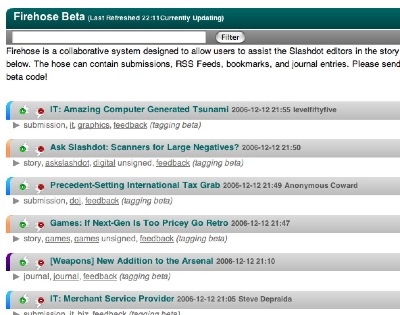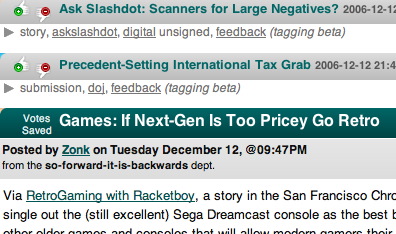So, you’ve built your totally kick ass web 2.0, long tail, peer to peer, social networking, beta meme review wiki that has all the paradigm shifting, AJAX created reflections you can shake a stick at.
You’ve been on TechCrunch, Engadget, Boing Boing and you’ve been properly Dugg. You’ve gotten great press and lots of people have tried your site. Trouble is, people come to your site once and return only periodically, but they never add anything to your site. The trouble is, your site isn’t fun.
Make your site fun
I heard a talk that Amy Jo Kim gave back at Etech that really stuck with me.  She talked about using gaming mechanics to make your site more fun. Gaming mechanics are essentially elements of games that make them addictive by employing elements of behavioral psychology. A great book on this is Theory of Fun
She talked about using gaming mechanics to make your site more fun. Gaming mechanics are essentially elements of games that make them addictive by employing elements of behavioral psychology. A great book on this is Theory of Fun by Raph Koster. According to Raph, “fun is about our brain feeling good.”
by Raph Koster. According to Raph, “fun is about our brain feeling good.”
I thought about the sites I’ve liked, used and help design and the best, most successful ones all use gaming mechanics to bring people in and keep them there. Community based sites tend to use this best.
I’ll give you the basic outline of some gaming mechanics and then draw a few examples from a number of sites.
Gaming Mechanics
Amy Jo outlines 4 very powerful techniques to bring people back in droves. Most of these items aren’t intended for blogs, but for community based web sites.
- Collecting
- Earning points
- Levels
- Scheduled Reward
Each one is a powerful mechanism, but used in combination, they add up to a pretty addictive experience for some. For today, I’ll talk about collecting.
Collecting
Collecting is essentially amassing stuff and showing it off. You know people that are very susceptible to this. Your crazy aunt’s beanie baby collection or your friend who bought all those Magic cards back in college are great “real world” examples of this behavior. Collecting is directly related to the primal instinct to hunt and gather. Primitive men and women who were good at hunting and gathering got better mates. Web sites use this mechanism very successfully (although this is often counter to attracting better mates).
Xbox Live
Ok, I realize that Xbox Live isn’t just a website but it serves as a great example.
When Microsoft launched Xbox Live, they did it to reinforce certain activities they wanted gamers to engage in. The folks at Microsoft want you to a. buy an Xbox and b. buy games. One way to get users to do this is to make the games fun (naturally), but building in some extra elements of fun can’t hurt reinforcing this.
On the Xbox Live site, you can show off your gamer card that shows all the games you’ve played and the “achievements” you’ve collected in a given game. You can then compare how well you’ve done against your friends.

Comparing accomplishments and competing against friends is pretty powerful and it makes you want to do better than your friends to show off. Finishing a game, having a higher score, accomplishing something difficult both increases your score (which gets into Points) and the number of accomplishments
Naturally, adding lots of friends to your Xbox profile is powerful as well, but it’s even more powerful on LinkedIn.

Must. Complete. Profile.
There are a number of activities on LinkedIn that are natural. First, adding your immediate friends and colleagues is probably the reason that you are there, so that’s a no brainer. But adding a recommendation isn’t necessarily a natural thing, but yet you feel compelled to do so in order to have a complete profile. It’s also something that strengthens LinkedIn’s network. That ties into the end point of collecting and that is completing a set.
When talking about collectible card games, beanie babies, Xbox live profiles, or whatever, completing a set is what you are striving for. No one wants an incomplete set and marketers are keen to exploit this angle.
What do your users collect? What sets do your users need to complete?
More later.

 Or anyone who has ever used a social network or a service with feeds…
Or anyone who has ever used a social network or a service with feeds…











 She talked about using gaming mechanics to make your site more fun. Gaming mechanics are essentially elements of games that make them addictive by employing elements of behavioral psychology. A great book on this is
She talked about using gaming mechanics to make your site more fun. Gaming mechanics are essentially elements of games that make them addictive by employing elements of behavioral psychology. A great book on this is 

